Finding information
Searching for specific resources
You will be able to locate most of the resources that you need for your university assignments by searching in the Curtin Library catalogue or one of our databases; however, some resource types may require a more targeted approach. This page provides you with some tips on the best places to look for different types of information, as well as strategies that will improve your searching success.
Use the menu below to select the kinds of resources you are trying to find (or learn more about).
You should always quality-check the information you would like to include in your assignments. See Critical reading for tips on evaluating sources.
Standards
“Standards are voluntary documents that set out specifications, procedures and guidelines that aim to ensure products, services, and systems are safe, consistent and reliable. They cover a variety of subjects, including consumer products and services, the environment, construction, energy and water utilities, and more” (Standards Australia).
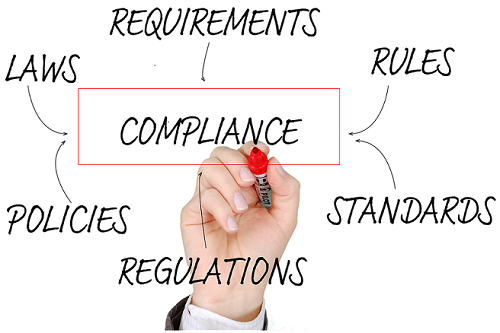
Why use standards?
Standards aim to provide best practice approaches in a range of different fields, from food safety to farming, to medicine, prioritising safety and quality. They are often referenced in government legislation and provide guidelines on how to approach different tasks.
Watch What ISO standards do for you (International Standards Organization) for more information on standards.
Where can I find standards?
The Library provides access to standards via the databases listed below.
Provides full-text access to Australian standards.
Provides access to American Society of Testing and Materials standards.
Select Standards from the Browse drop-down list to view a list of standards available from IEEE.
The National Construction Code, Building Code of Australia and Plumbing Code of Australia are now freely available.
Standard not available? Curtin staff and postgraduate students may request other standards (for example ISO, IEC) through Intertek Inform. Search for the standard, open the record, then click Request Access on the right side. The Library will be notified of the request and investigate access.
Tips for finding standards
- When searching for standards try a search using the complete title of the standard or the standard number (e.g. ASCRM 035:2014). You may find that a keyword search provides too many results.
- Standards are regularly updated so make sure you have the current version. Databases will make it clear if a standard is current or historical.
- Most standards providers have digital rights management incorporated into their products. This means the files you download may only be visible for a few days.
- Many ISO standards have equivalent Australian / New Zealand Standards. If you are looking for ISO standards, search for the standard number (e.g. 9000:2016) as there may be an identical standard available (e.g. AS/NZS ISO 9000:2016) in the database.
Downloading standards
Some databases have restrictions on how their content can be used to ensure all users comply with Digital Rights Management (DRM), and do not breach the license agreement or copyright legislation. To download and access DRM protected standards on your computer:
- Ensure you have Adobe Acrobat Reader installed. This will need to be used to open the PDF.
- Locate the standard you require in the database and click Download. Note the location that the file is downloaded to (e.g. your Downloads folder). Do not try to open the download file in the browser.
- Go to the location on your computer where you downloaded the standard and open the file using Adobe Reader. You may need to right-click and select “Open with…”.
- You should now have access to the Standard on your computer. As it is protected by DRM it is only for your use, you cannot email or share it with other people.
Case studies
A case study is a research approach that investigates a topic or issue by focusing on a representative person, group of people, or other sample. Observations and conclusions gained through these focused investigations are then (tentatively) applied to larger populations.
Case studies are often used in the social and health sciences, but may also be employed in other subject areas. A good case study avoids overgeneralisations, is forthcoming about its limitations (such as small population sizes), and examines a wide range of factors that could explain a particular outcome.

Why use case studies?
A case study allows researchers to investigate large and complex problems in a manageable way. It is not always possible to look at an entire population but identifying a representative sample allows researchers to draw conclusions that may apply beyond the sample size.
Case studies will often:
- Contain both quantitative and qualitative data, allowing for a rich level of detail when exploring a particular issue.
- Examine a number of different variables, allowing for a more holistic understanding of a situation or intervention.
Tips for searching for case studies
- Case studies are often published in journals for an academic or professional audience. When searching you will need to keep this in mind, and use appropriate discipline-specific language to increase your chance of success
- Many of the library’s databases will allow you to limit your results to case studies. Look for options to do this in fields like document type, publication type or article type
- If you don’t see an option to limit to case studies in the database you are searching, you can include “case study” or “case studies” as search terms, e.g. business ethics AND “case study” OR “case studies”.
Where can I find case studies?
CINAHL is a good database to search if you are looking for case studies in the field of nursing and allied health. You can limit your search to case studies by selecting Case Study under Publication Type.
Business Source Ultimate is a useful source of case studies in the business field. You can limit your search by selecting Case Study as a Document Type or Publication Type.
Emerald covers a wide-range of subject areas, including management, information science, engineering, education, health and social care. You can limit your search to case studies in Advanced Search by ticking the Case studies option above the search box.
ProQuest is a multidisciplinary database covering a wide range of subject areas. You can limit your search to case studies by selecting Case Study in the Document type field.
WARC is an advertising and marketing information database and includes advertising effectiveness case studies. Select Case studies under the Strategy drop down menu to access the Case Finder.
Conference papers and proceedings
A conference paper is the text of a paper or presentation given at a conference. Papers from a particular conference are often compiled together as a conference proceeding.
Conference papers and proceedings are published in a variety of ways, which can make them tricky to find. They may be published as a book, a journal article, a special issue or supplement of a journal, or as part of a series. Sometimes the organisation that holds the conference may only publish abstracts from the conference, and not the entire papers. Authors may also publish their conference papers on their own website or on an institutional website. On other occasions conference papers may not be published at all!

Why use conference papers and proceedings?
Conference papers present the latest research and advancements. Therefore, conference papers and proceedings can be a great source of current research and leading information in a field.
Tips for searching for conference papers and proceedings
- Try a search using the complete conference title, or a few keywords with the location and year of the conference. You can also search for a specific conference paper if you have its title or author’s name
- Many of the library’s databases will allow you to limit your results to conference papers. Look for options to do this in fields like document type, publication type or article types.
Where can I find conference papers and proceedings?
A search in the library catalogue or databases may find conference papers or proceedings published in journals, journal supplements, books or series. Be aware that published proceedings may not include ALL of the papers presented at the conference, especially if some papers are not peer-reviewed.
Searching the Curtin Library catalogue:
To find conference material in the library catalogue limit your search results to Conference Proceedings or Conference Papers under Resource Type.
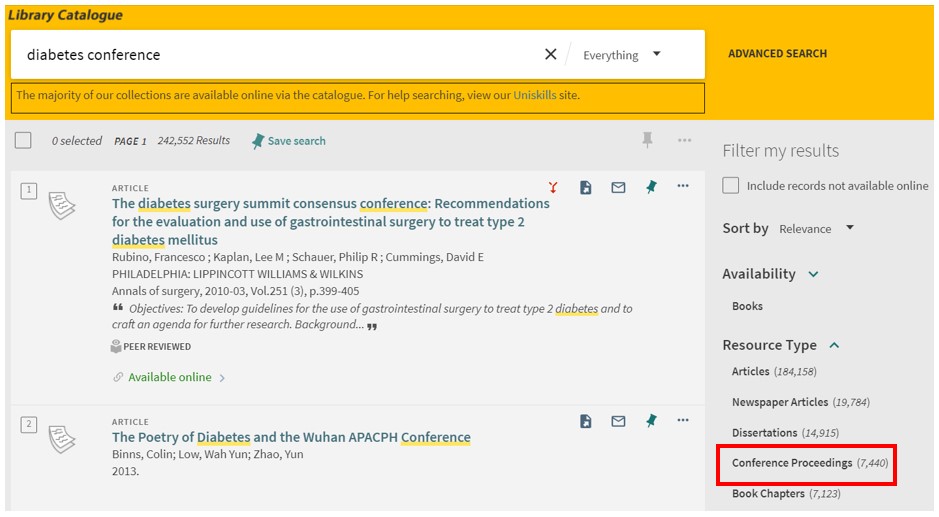
Searching the Library databases:
Many library databases index published conference papers and proceedings. Some key multidisciplinary databases that index conference papers/proceedings are listed below:
Scopus is a large abstract and citation databases of peer-reviewed literature, including conference proceedings. It covers science, technology, medicine, social sciences, arts and humanities.
Web of Science indexes core journal articles, conference proceedings, data sets, and other resources in the sciences, social sciences, arts, and humanities.
ProQuest is a large multidisciplinary database that indexes a diverse range of content including conference papers. Limit to Conference, Conference Paper or Conference Proceeding under Document type options.
Other sources:
Many conference proceedings are not indexed in the Library catalogue or databases, but may be freely available, and can be found through a search on Google Scholar.
Unpublished conference papers or proceedings are more difficult to track down. Often the title, author and abstract will be listed in a ‘Book of abstracts’ included as a supplement of a journal issue, but these don’t point you to the full text.
Unpublished papers from a conference may be made freely available on the website of the host organisation, or distributed to attendees only. Some authors make their work available on their own website or via their institution’s repository, or you may need to contact the author to request a copy of their paper.
Datasets
Data is the raw information and the direct result of research that was conducted as part of a study, experiment or survey. It is typically raw data that needs to be manipulated using software.
Datasets are groupings of data collected and arranged in a set or structured manner. The records in a dataset can be organised in various ways, depending on how you wish to access the information. When a dataset has been created by another researcher or research group, it is classed as secondary data.

Why use datasets?
The Open Data movement predicts a huge potential for using a nation’s extensive datasets for research purposes, namely to stimulate research, innovation and industry.
There are benefits associated with using datasets:
- Much of the background work has already been completed making it easier to undertake further research
- Time-saving and cost efficient - reduced cost associated with duplication of data
- Pre-established validity and reliability
Where can I find datasets?
Finding data for your research can be time consuming and may involve searching major sources of published research data such as: government websites, data directories, subject-based repositories, institutional repositories, research centre websites or Internet search engines e.g. Google or Google Scholar.
Key Australian repositories
- Research Data Australia (RDA)
- Dataplace
- data.gov.au
- Australian Data Archive
- CSIRO Data Access Portal
Commercial data repositories and registries
International data archives
How do I know if a dataset is useful?
Once you have selected a dataset you wish to use, consider the following before you start using it:
- Is there enough description about the content of the data? Is the context of the research relevant?
- Is the source trustworthy?
- Is the file format useable?
- Are the conditions for re-use clear?
- Does the data have a persistent identifier (DOI)?
- Do you know how long the data will be stored and made available?
Using datasets
Research data which is intended for sharing and re-use should have an assigned license. When you use datasets that have been licensed, ensure you use it in a the way that is permitted by the license.
If the data has not been licensed, contact the data owner (rights holder) to obtain permission to re-use the data.
Drug resources
Drug resources provide information on the identification and prescription of drugs, including information on dosage, side effects, drug interactions, ingredients and more.

Why use drug resources?
You may be required to access and use up-to-date drug information for your assignments and research in the health sciences. These resources will help you find accurate information about drugs, their interactions and adverse effects.
Where can I find drug resources?
The library provides access to a range of drug databases and resources to assist you in finding accurate, evidence-based information.
AMH provides a concise, up-to-date source of independent drug information to facilitate effective, rational, safe and economical prescribing and dispensing.
The Children’s Dosing Companion provides information for prescribing and administering medicines to children from birth to 18 years.
MIMS Online contains both abbreviated and full prescribing information, consumer medicine information and product images for pharmaceuticals available in Australia.
Martindale is a comprehensive reference resource on drugs and medicines used throughout the world. Coverage includes: drug monographs, propriety preparations, manufacturers and disease treatment reviews.
Therapeutic Guidelines contain searchable, peer-reviewed clinical guidelines covering a broad range of topics. It also contains drug information and dosing regimens for a range of diseases.
Provides information on the selection, prescribing, dispensing and administration of medicines.
A source book of drug interactions, their mechanisms, clinical importance and management. Covers interactions between therapeutic drugs, proprietary medicines, herbal medicines, foods, drinks, and drugs of abuse.
Pharmacopoeias
Pharmacopoeias provide standards for pharmaceutical substances and medicinal products used in a country. These legally binding standards are important in regulating the quality of medicines.
Complementary and Integrative Medicine
Complementary and integrative medicine should be considered alongside drug interventions in terms of their efficacy, but also their interactions and toxicities.
ebooks
An ebook (short for electronic book) is simply a book which can be accessed online.

Why use ebooks?
Ebooks, like print books, are a great source for an introduction to a particular topic. As they tend to be longer, books go into greater detail than other resource types and will often introduce and explain established theories, providing notable examples of research conducted in a particular field.
Where can I find ebooks?
The easiest way to locate ebooks is by searching the Library Catalogue.
- Enter keywords from your topic in the search box and then click on the Search button
- On the results page, refine by selecting Available Online filter in the right side menu
- Then select the Books Resource Type to limit your results to ebooks only.
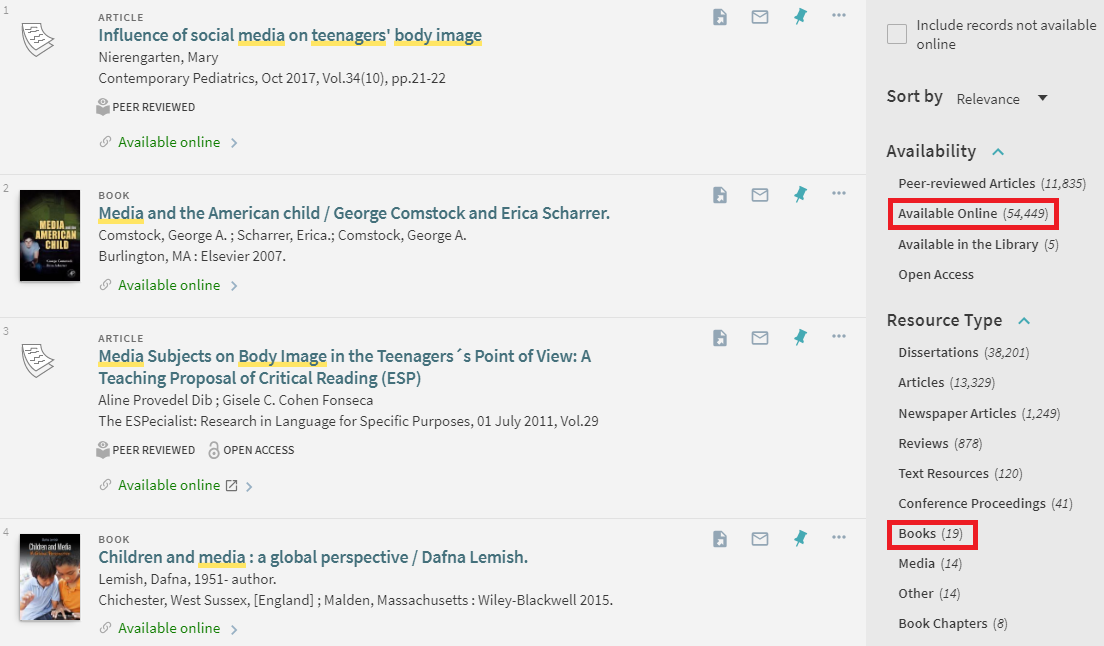
Once you have found a suitable ebook, select Available Online in the item record. This will provide the link to the database where you can read (and sometimes download) the ebook.
How to use ebooks
Ebooks work differently to physical books. They do not need to be borrowed by using your library card. When downloaded, they are not recorded as a loan on your library record, and they do not need to be returned (as this will happen automatically).
However, many ebooks are protected by Digital Rights Management (DRM), which affects how you can use them.
All ebooks can be read online. As long as a copy of the book is available, you can read the item online for as long as you require. Your session needs to remain active. If you stop interacting with the book, your session will time out and you may need to reopen the item via the library catalogue.
Many ebooks are now offered in EPUB format instead of PDF. This is because EPUBs are more accessible and integrate with tools like screen readers more easily.
Titles in EPUB format have dynamic page numbering, which means the page numbers can change to accommodate features like changing text size. As a result, it’s best not to use page numbers in referencing for ebooks accessed as EPUBs. To see how to cite direct quotations of materials without using page numbers, check the UniSkills referencing guide for your required referencing style.
Some ebooks will give you the option to download the entire book or a chapter of the book so the content can be viewed while you are not connected to the internet.
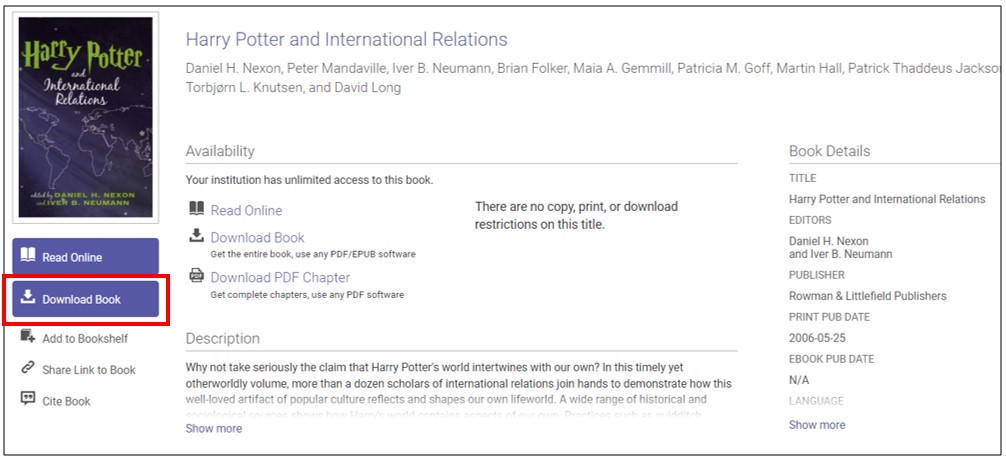
For entire book downloads, often, you will have to download an app. Follow the prompts for the database you are in to download the necessary software.
Once downloaded, you will usually have between 1 - 14 days of offline access to the book. Once the download period has ended, the ebook expires and can no longer be opened. You will need to download it again if still required.
For chapter or limited page downloads, the content will usually be downloaded as a PDF and can be viewed in a PDF reader or your browser.
It is possible to print or download chapters of some ebooks, however DRM will determine how much printing or downloading is permitted. Most of the time, you will be allowed to print, save, or download one chapter of an ebook (in line with the fair dealing provisions of the Australian Copyright Act 1968) so choose carefully.
Some ebook platforms will allow you to highlight or make notes while you’re reading the book online. Changes you make will then be saved so that the next time you access the book, they will be visible (you may be prompted to create an account or login).
Why can’t I open an ebook?
DRM determines the number of people who can access an ebook at any given time, depending on the number of licenses available. As when a physical item is checked out of the library, some ebooks cannot be opened if another person is looking at them.
We know which of our ebooks are likely to be in high demand and have disabled the option to download them. If you are trying to access an ebook which can’t be opened, or will only allow you five minutes for reading, try again later (and avoid peak times like the middle of the day).
Grey literature
Grey literature refers to both published and unpublished research, produced by government, academia, business and industry, that is not controlled by commercial publishers. Some examples of grey literature include:
- Government reports
- Newsletters
- Theses
- Policy documents
- Fact sheets
- Surveys and interviews
Why use grey literature?
Grey literature is an important source of information as:
- It can help address biased reporting of research results (publication bias) and provide a more balanced view of a topic
- It can be a good source of up-to-date literature for new or emerging areas of research
- In some topic areas (e.g. social sciences, government policy), a large amount of the evidence is communicated through grey literature.
Tips for searching for grey literature
Searching for grey literature is not always easy and can be time consuming. Simple searches are often more fruitful than the rigorous strategies used for database searching. Try searching on your core concepts rather than using long strings of search terms.
If using a search engine such as Google and Google Scholar, use the Advanced Search option. This will allow you to limit your search by date (e.g. last 5/10 years), language (e.g. English), region (e.g. Australia) etc. thus avoiding the retrieval of large numbers of results.
When you perform a Google search you can also limit to particular domains or by file type:
- “Sustainable tourism” AND poverty site:gov.au will look for Australian government websites with information on sustainable tourism and poverty
- “Sustainable tourism” site:org will look for organisational websites on sustainable tourism
- “Sustainable tourism” AND poverty alleviation filetype:pdf will look for PDFs on sustainable tourism and poverty alleviation.
Where can I find grey literature?
Websites of relevant organisations
Search or browse the websites of key organisations in your research area. These may include: government agencies, academic or research institutes, private companies, professional associations, and advocacy groups. Depending on the focus of your topic, the following sources may be useful:
- Analysis & Policy Observatory (APO)
- Australian Institute of Health & Welfare
- Australian Government Directory
- International Labour Organization
- Transparency Portal - Australian Government
- United Nations
- World Health Organization
Library databases
As well as journal articles, many library databases also index other types of literature including conference papers, reports, theses and government documents.
- Scopus and Web of Science index conference papers and technical and other reports.
- ProQuest indexes dissertations and theses, and conference papers and proceedings.
- Informit (an Australian database) indexes conference papers and many government documents.
Most library databases provide the facility to limit by publication or document type, which will allow you to narrow your search to grey literature sources.
Grey literature databases, library catalogues and repositories
- Specialised databases, such as GreyNet, index grey literature in a number of subject areas.
- Trove is an overarching search interface to search the content of most Australian libraries as well as archives and repositories.
- Institutional repositories, such as espace at Curtin, hold digital theses and research papers. Open Access Australasia provides a list of research repositories.
Images
In its broadest sense, an image is a visual representation or likeness of a person or thing. Images can include paintings, photos, drawings, cartoons and illustrations, diagrams, graphs, computer graphics and plans.
An original image is considered an artistic work and is protected by copyright legislation.

Why use images?
Images can enhance your assignments by providing visual aids for your research or decorative images for your presentations.
Ownership and use of images
It is important to consider copyright obligations when reusing an image. Don’t assume that a freely accessible image is also freely available to use without permission. This article about copyright infringement illustrates the importance of permission checking before reusing images found on the web.
Many images can be freely downloaded under certain terms and conditions, while websites such as Associated Press, iStock by Getty Images, and Shutterstock require payment for a license to reuse content.
Open license, Creative Commons and public domain images
One of the easiest ways to successfully navigate your copyright obligations is to select Open License, Creative Commons (CC) or public domain images.
An Open License is one that grants permission to access, reuse and redistribute work with few or no restrictions. Creative Commons is the most well-known open license system.
A Creative Commons license doesn’t replace copyright. CC material is still protected by copyright, but the copyright owners have provided upfront permission for others to reuse their content in particular ways. You don’t have to seek permission from the copyright holder as long as you abide by the conditions set out in the CC license. You can find out more about the various CC licenses through the Creative Commons website.
Public domain images can refer to material in which copyright has expired and can be used without restriction; or where the copyright owner gives very broad permissions to people to use the content freely.
Where can I find Open License, Creative Commons and public domain images?
The following websites provide easily accessible advance search filters to quickly identify Creative Commons or public domain images:
- flickr
- Openverse
- Wikimedia Commons
- The New York Public Library Digital Collections
- State Library of Victoria copyright-free image search
- Unsplash
Attributing open license, Creative Commons or public domain images
If your work will be publicly available, to abide by the terms of a Creative Commons license, you may also be required to provide an attribution statement.
To properly attribute content offered under a Creative Commons license:
- Credit the creator
- Provide the title of the work
- Provide the URL where the work is hosted
- Indicate the type of license it is available under and provide a link to the license (so others can find out the license terms)
- Keep intact any copyright notice associated with the work
For more information about creating a Creative Commons attribution statement, see Best practices for attribution.
Referencing for Curtin University assignments
When reproducing images, you will need to ensure that you are referencing in accordance with the appropriate referencing style for your unit. Please refer to our referencing tables and figures guides for information:
Legal materials
Materials used in legal research are often divided into two broad categories:
-
Primary legal sources are created by parliament (government), the courts, and other official bodies and include legislation and case law.
-
Secondary legal sources are based on primary legal sources, helping to explain, analyse, and interpret the law. These include journal articles, books, legal dictionaries, commentaries, and newspapers. Secondary legal materials can be helpful in the identification of relevant primary sources.

Why use legal materials?
Legal materials are fundamental to the practice of law; however the need to locate legal materials is not constrained to those studying or working in that particular field. The law impacts every facet of our society, governing what individuals and organisations can and cannot do. For that reason, it may be necessary to locate legal materials across a number of topics or subject areas.
How can I find legislation?
Legislation consists of the laws made by parliament. There are two main types of legislation: Acts (also called Statutes or Acts of Parliament) and subsidiary legislation (also known as subordinate or delegated legislation) which includes regulations, rules, orders, statutory instruments and by-laws.
Australian legislation can be found on government websites:
- Western Australian Legislation
- Federal Register of Legislation (Commonwealth)
How can I find case law?
Cases (also referred to as court decisions, judicial decisions or judgments) are written records of the legal decision-making applied to an individual dispute. Under the common law system (as opposed to statute law or legislation), courts can clarify or change the law, setting a precedent which is then applied to later cases.
Before searching for a case, it is helpful to understand the elements of the case citation:
Commonwealth v Tasmania (1983) 158 CLR 1
- Commonwealth v Tasmania is the case name and tells you the plaintiff and defendant respectively
- 1983 is the year published
- 158 is the volume number of the law report series the case appears in
- CLR is the abbreviation for the law report series (in this case CLR stands for Commonwealth Law Reports)
- Finally, you have the starting page of the report.
To locate a particular case:
- Find out the full law report series name. Legal abbreviations (Monash University Library) provides a comprehensive list of abbreviations used in law
- Search for the full name of the Law report series in the Library Catalogue
- Click Available online to see the database that holds the law series
- Go to the database and search for the case name or citation information to find the case.
Search legal databases
The following are a selection of databases which include legal materials. For more legal databases, see the Databases A-Z.
- Lexis Advance Pacific - Search Lexis Advance for primary and secondary legal materials covering Australia.
- Westlaw AU - Covers Australian legal journals, case law, commentaries, precedents, encyclopedia and legislation.
- CCH IntelliConnect - Search CCH IntelliConnect for Australian and (some) international commentary, cases, legislation, news and more.
- AustLii - Open access database of Australian Commonwealth and State legal information. Content includes full text legislation, case law, journal articles and other legal materials.
Further resources
For more information on finding legal materials see:
Newspapers and other media sources
Newspapers and other media sources keep us informed, discussing current or recent information of either general interest (for example daily newspapers like The Australian or the New York Times), or a specific subject focus (e.g. political or trade news like the Foreign Policy or the Australian Financial Review).
Media sources include newspapers, magazines, TV current affairs programs, online news organisations and news blogs.

Why use news and other media sources?
News and other media sources provide up-to-date reporting on events as they are occurring, while journal articles and books may take months or years to move through the publication process. Media sources are great for images, quotations, opinions, and other primary source material. They can:
- Present issues in the context of when they occurred. The way issues are discussed is likely to closely align with the feelings and opinions of the general population at a particular time;
- Seek comment or opinions from representatives of both sides of an argument, providing multiple points of view about an issue;
- Present statistics as they are released, including data related to jobs, economic outlook, health, companies and industries.
News and other media sources reflect matters that are of interest to the population they serve, whether that be the general public or a more specific audience.
Tips for searching for news and media sources
Searching for news and media sources may require a different approach than searching for journal articles or other academic content. They are usually aimed at a general audience, so it is best to avoid using technical language and discipline-specific jargon in your search to increase your chance of success.
Consider the difference between the language used in the newspaper article headline and the journal article title below:
-
Newspaper headline: Forecasts put WA Back in the Boom Business
-
Journal article title: Entrepreneurial and Business Growth and the Quest for a “Comprehensive Theory”: Tilting at Windmills?
Where can I find news and media sources?
You can often find news and media reports by searching Google. However, you may not be able to access the full content without paying for a subscription. If this happens, try searching in the databases listed below.
NewsBank provides access to a wide range of Australian and international news sources. Includes The Australian, Australian Financial Review, Sunday Times, West Australian and National Indigenous Times.
Factiva has a large collection of Australian and international newspapers.
ProQuest provides access to over 2,000 newspapers including 300 Australian newspapers and 63 related specifically to business and economics.
Provides access to archived digital editions of the West Australian newspaper from 2004 onwards. It is updated daily with each edition available the day after publication.
An archive of Australian television news, current affairs and selected documentaries from the free-to-air networks. The content is mostly video, however detailed synopses are also provided for each entry.
Original research articles
Original research articles (also known as primary research articles or empirical articles) are journal articles that provide a detailed account of the techniques and methods used by researchers to conduct their own research. These articles undergo a rigorous peer review process where experts in the same field evaluate the research methodology and data collection before publication.
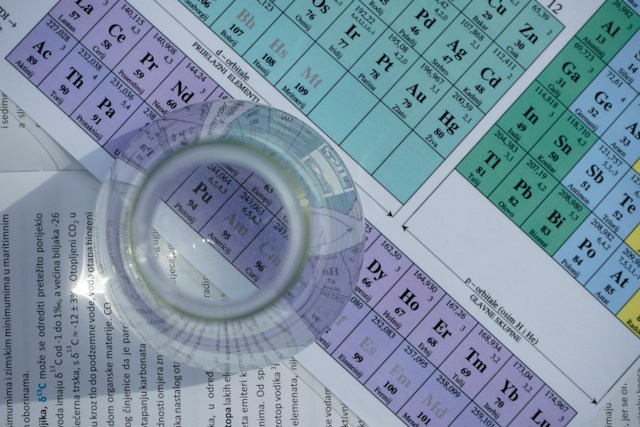
Why use original research articles?
Original research articles supply the results and data of scientific research as first reported and serve as the raw material for further research.
How do I know if an article is original research?
Original research articles:
- Include the following sections: background/literature review, methods/methodology, results, discussion and conclusion
- May mention the type of study conducted (e.g., cohort study, longitudinal study, randomised controlled trial etc.) in the title or abstract (summary) of the article
- May be labelled as Original research, Research article, Original article or similar.
Some articles may appear to be original research but are actually reviews of previously published research. Keep an eye out for terms such as review, systematic review, meta analysis, retrospective study, literature review etc. as these types of articles are considered secondary sources.
Tips for finding original research articles
- Add terms such as trial or study to your topic search, e.g. play or pretend play AND child development AND study or trial
- Check the databases for limits such as ‘Research articles’ or options to filter to particular study designs (e.g. randomised controlled trials)
Where can I find original research articles?
Databases are a great source for journal articles on a wide range of topic areas. Below are a selection which are useful for finding original articles.
You can refine to Research articles under Article type on the search results page. Note that some systematic reviews may be included so check the abstract for further details about the type of research conducted.
Add the term trial or study to your topic search. Check the abstract for further details about the type of research conducted as review articles may be included in the results.
Perform a search for your topic. Once results are returned, click Additional Limits. Under Methodology, select relevant study types e.g., Clinical trial, Empirical study, Field study, Qualitative study, Quantitative study… and click Limit a Search.
Patents
A patent is a legal right granted to a person or organisation to commercially exploit a new invention (device, substance, method or process). The patent excludes others from selling or using the invention for a set period of time (the life of the patent).

Why use patents?
A patent includes a description of the nature of the invention, and is often the first place that information on a new area of research is made public. As patents must disclose (in some detail) the nature of the invention, details disclosed in an existing patent may save you from undertaking unnecessary research.
Where can I find patents?
In most countries patents are issued by a single authority, and are available on the official website. Some useful search tools for finding patents include:
IP Australia administers Intellectual Property issues in Australia, and using their website, you can search for patents, trademarks and designs.
Allows free searching for USA granted patents. It contains the full text and drawings of USA patents since 1976.
Contains patent applications issued by both the European Patent Office (EPO) and the World Intellectual Property Organisation (WIPO).
Provides access to international Patent Cooperation Treaty (PCT) applications in full text format on the day of publication, as well as to patent documents of participating national and regional patent offices. This database is also hosted by the World Intellectual Property Organisation (WIPO).
A not-for-profit organisation that provides universal access to patent information, including biological sequences. It also includes some analytics such as patents which cite a journal publication.
Includes over 120 million patent publications from 100+ patent offices around the world.
Primary sources
A primary source provides a first hand account of a topic. Primary sources report on events or discoveries, or share new information. They are original materials which have not been filtered or changed through interpretation, condensation or evaluation by a second party. In contrast, secondary sources are not original sources of information; instead they describe, analyse, summarise or discuss the information from primary sources.
Plays, photographs, news reports, diaries, surveys and social media content are just some examples of primary sources.
Journal articles can be primary or secondary sources. Original research articles that provide a detailed account of research activity, written by the scientists who conducted the research, are primary sources.

Why use primary sources?
Primary sources are valuable for a number of reasons. They:
- supply the results of scientific research as first reported
- can offer an inside view of a particular event
- provide insights into how people view their world at a particular time
- serve as the raw material for further research.
Where can I find primary sources?
Library Catalogue:
Many primary sources can be found in the Curtin Library Catalogue, including newspaper articles, images, government documents, and research datasets. You can use the options under ‘Resource Type’ (found on the right-hand side of the screen) to limit your search to specific types of primary source material.
Other sources:
This site provides links to the resources of Australian Archives as well as to most other major archives in Australia.
Trove is the National Library’s ‘discovery service’ for information, resources and people. You can search for pictures and photos, digitised newspapers, diaries, letters, music, sound and video.
Search Google to discover blogs, social media content, statistics, court records, historical documents, autobiographies and more.
Reports
“A report is a specific form of writing that is organised around concisely identifying and examining issues, events, or findings” (Massey University, 2012). It usually covers the who, what, where, when, why and how of a particular situation, issue, or problem, and may be produced by government departments, research groups, not-for-profit organisations, companies, and others.

Why use reports?
- Reports are generally highly specific and go into quite a bit of depth, providing you with a complete picture on whatever subject they are covering.
- Reports are written by individuals or organisations that are strongly linked to the subject matter. They can provide the context for why particular decisions were made, specific directions were taken, particular problems tackled and so on. You are getting information direct from the source.
- Reports will often contain information that will not be available elsewhere.
You will need to exercise some caution when accessing certain types of reports. Company reports and reports produced by charity organisations, for example, are produced largely for marketing purposes. It is possible that positive information will be highlighted, while more negative material is glossed over or omitted altogether.
Tips for searching for reports
Reports will generally be available for free on the Internet, and simple strategies are often more fruitful than the rigorous strategies used for database searching.
Websites of relevant organisations
Search or browse the websites of key organisations in your research area. Looking out for links to ‘publications’, ‘reports’, or ‘collections’ can help. Remember, reports are produced by companies, government departments, professional associations, not-for-profit or charitable organisations, academic or research institutes and may more. Depending on the focus of your topic, the following sources may be useful:
- Analysis & Policy Observatory (APO)
- Australian Government Publications Guide (GovPubs)
- Australian Institute of Health & Welfare (AIHW)
- International Labour Organization (ILO)
- Transparency Portal
- United Nations
- World Health Organization (WHO)
Online search engines
Search engines such as Google are useful when searching for reports. Most reports will be published online in PDF form, so it’s helpful to limit your results by file type:
- “Renewable energy” AND Australia filetype:pdf will search for PDFs on renewable energy and Australia.
- “Renewable energy” filetype:pdf site:gov.au will search for PDFs on renewable energy from Australian government websites.
Google searches will often return large numbers of results so consider limiting your search by date (e.g. last 5/10 years) etc. in Advanced Search.
Statistics
Statistics is the practice that deals with the collection, organisation, analysis and interpretation of numerical data. General conclusions about a set of data are then able to be drawn from a sample of the data.

Why use statistics?
Statistics allow us to draw accurate conclusions about a population from a limited sample. They inform research, decision making and societal insights, and are often presented as tables, graphs or charts. In your studies, using statistical data can enhance your research, lending credibility to your work and support your ideas or position.
Tips for finding statistics
- Include the term ‘statistics’ alongside your other topic keywords when performing a search, e.g. Indigenous education AND statistics.
- Look at the websites of government and non-government organisations, private companies or academic institutions responsible for collecting and reporting on statistics.
- Limit your search to a particular website or domain, e.g. add site:gov.au to your search to find statistics on Australian government websites, e.g. Indigenous education statistics site:gov.au
Regardless of the subject, statistics are often limited by both time and geography, and you may not always be able to find the exact data you are looking for. It is important to bear in mind that:
- It takes time to collect and publish statistical data, so you may not be able to find the most current statistics on your topic.
- The data may have never been collected or may be held privately and not available to the public.
- Statistical data for some countries can be difficult to find, so you may have to search for the broader region. For example, if you are not able to find statistics for Germany, you may need to search the broader region, Europe.
Where can I find statistics?
Statistical data is not always easy to locate as as there is no one single source for this type of information. Most statistics are published by national or state government agencies. However they can also be found in scholarly journals, reports, websites, books, databases, and newspapers.
Websites of relevant organisations
The following websites provide statistical data for Australia and other countries around the world.
The ABS is responsible for statistical collection and analysis for Australia’s federal, state and territory governments. It provides key economic, financial and census data for the Australian economy.
The AIHW produces authoritative and accessible information and statistics to inform and support policy and service delivery decisions for all Australians.
RBA, Australia’s central bank, provides economic and financial data produced by the Reserve Bank and other organisations.
The European Union’s statistical information service, responsible for publishing high quality Europe-wide statistics and indicators.
Provides global statistical coverage on economics, trade, industry, finance, employment and health.
Compiles and disseminates global statistical information including economic, demographic, social, environment and energy statistics along with the National Statistical Offices for member countries.
Compiles the most recent available data on health and health-related indicators, including topics such as mortality and burden of disease, health systems, health equity, and more.
Provides information on international trade figures for commodities and commercial services such as transport and financial services.